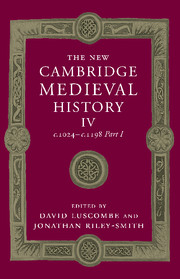Book contents
- Frontmatter
- 1 Introduction
- 2 The Rural Economy and Demographic Growth
- 3 Towns and the Growth of Trade
- 4 Government and Community
- 5 The Development of Law
- 6 Knightly Society
- 7 War, Peace and the Christian Order
- 8 The Structure of the Church, 1024–1073
- 9 Reform and the Church, 1073–1122
- 10 Religious Communities, 1024–1215
- 11 The Institutions of the Church, 1073–1216
- 12 Thought and Learning
- 13 Religion and the Laity
- 14 The Crusades, 1095–1198
- 15 The Eastern Churches
- 16 Muslim Spain and Portugal: Al-Andalus and its Neighbours
- 17 The Jews in Europe and the Mediterranean Basin
- 18 Latin and Vernacular Literature
- 19 Architecture and the Visual Arts
- List of Primary Sources
- Bibliography of secondary works arranged by chapter
- Index
- Frontispiece">
- Plate section"
- References
13 - Religion and the Laity
Published online by Cambridge University Press: 28 March 2008
- Frontmatter
- 1 Introduction
- 2 The Rural Economy and Demographic Growth
- 3 Towns and the Growth of Trade
- 4 Government and Community
- 5 The Development of Law
- 6 Knightly Society
- 7 War, Peace and the Christian Order
- 8 The Structure of the Church, 1024–1073
- 9 Reform and the Church, 1073–1122
- 10 Religious Communities, 1024–1215
- 11 The Institutions of the Church, 1073–1216
- 12 Thought and Learning
- 13 Religion and the Laity
- 14 The Crusades, 1095–1198
- 15 The Eastern Churches
- 16 Muslim Spain and Portugal: Al-Andalus and its Neighbours
- 17 The Jews in Europe and the Mediterranean Basin
- 18 Latin and Vernacular Literature
- 19 Architecture and the Visual Arts
- List of Primary Sources
- Bibliography of secondary works arranged by chapter
- Index
- Frontispiece">
- Plate section"
- References
Summary
the western church in the early eleventh century had emerged from almost 200 years of civil wars and invasions as a dynamic force, capable of rapid and successful expansion in adverse conditions. For since the Carolingian age Catholic Christianity had spread from its heartland in the British Isles, France, the empire, Italy and northern Spain, to become the official religion of Bohemia, Poland and Hungary and it was continuing to expand into the Viking homelands of Scandinavia and their new settlements in Iceland and Greenland.
A uniform though sparse church organisation existed throughout this huge area. All the Christian west was divided into dioceses, though they varied considerably in size; but the provision of parishes was very uneven. All towns had at least one church while some, like Rome, had more than a hundred, but even in parts of the west which had been Christian for centuries many rural areas were still served by the clergy of a central minster. The parish system was only gradually coming into being, and since over 90 per cent of the population lived in the countryside, this meant that a very high proportion of them had no regular access to a church.
Any attempt to generalise about the faith and practice of laypeople in the central middle ages is bound to be tentative. There is no statistical information available such as may later be found in parish registers, while the fairly abundant ecclesiastical legislation is often a better index of clerical expectation than of lay behaviour. Evidence about the religious observance of individuals relates chiefly to rulers and to members of the high nobility.
- Type
- Chapter
- Information
- The New Cambridge Medieval History , pp. 499 - 533Publisher: Cambridge University PressPrint publication year: 2004
References
- 5
- Cited by

